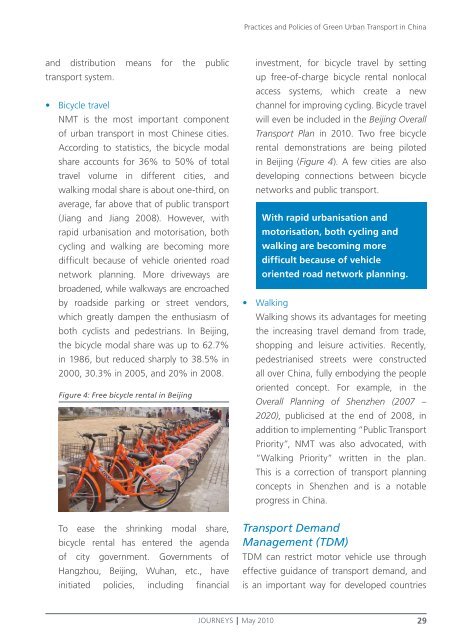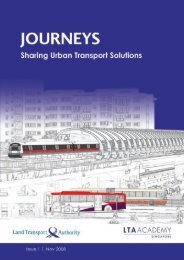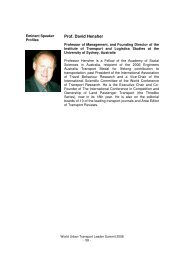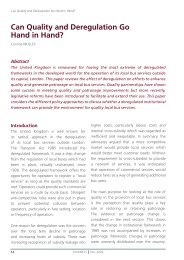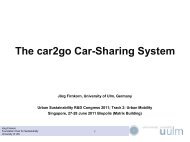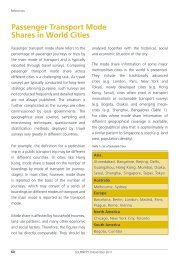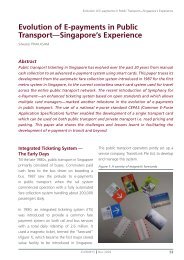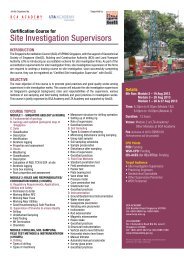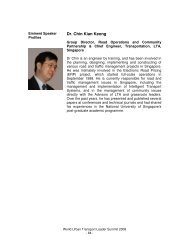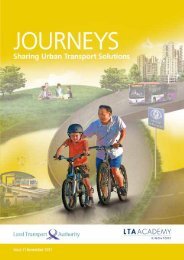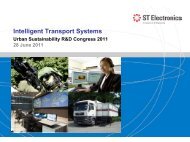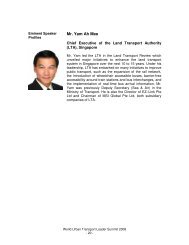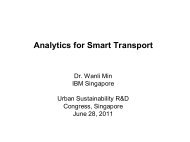Issue 4 May 2010 - LTA Academy
Issue 4 May 2010 - LTA Academy
Issue 4 May 2010 - LTA Academy
Create successful ePaper yourself
Turn your PDF publications into a flip-book with our unique Google optimized e-Paper software.
and distribution means for the public<br />
transport system.<br />
• Bicycle travel<br />
NMT is the most important component<br />
of urban transport in most Chinese cities.<br />
According to statistics, the bicycle modal<br />
share accounts for 36% to 50% of total<br />
travel volume in different cities, and<br />
walking modal share is about one-third, on<br />
average, far above that of public transport<br />
(Jiang and Jiang 2008). However, with<br />
rapid urbanisation and motorisation, both<br />
cycling and walking are becoming more<br />
difficult because of vehicle oriented road<br />
network planning. More driveways are<br />
broadened, while walkways are encroached<br />
by roadside parking or street vendors,<br />
which greatly dampen the enthusiasm of<br />
both cyclists and pedestrians. In Beijing,<br />
the bicycle modal share was up to 62.7%<br />
in 1986, but reduced sharply to 38.5% in<br />
2000, 30.3% in 2005, and 20% in 2008.<br />
Figure 4: Free bicycle rental in Beijing<br />
To ease the shrinking modal share,<br />
bicycle rental has entered the agenda<br />
of city government. Governments of<br />
Hangzhou, Beijing, Wuhan, etc., have<br />
initiated policies, including financial<br />
Practices and Policies of Green Urban Transport in China<br />
investment, for bicycle travel by setting<br />
up free-of-charge bicycle rental nonlocal<br />
access systems, which create a new<br />
channel for improving cycling. Bicycle travel<br />
will even be included in the Beijing Overall<br />
Transport Plan in <strong>2010</strong>. Two free bicycle<br />
rental demonstrations are being piloted<br />
in Beijing (Figure 4). A few cities are also<br />
developing connections between bicycle<br />
networks and public transport.<br />
With rapid urbanisation and<br />
motorisation, both cycling and<br />
walking are becoming more<br />
difficult because of vehicle<br />
oriented road network planning.<br />
• Walking<br />
Walking shows its advantages for meeting<br />
the increasing travel demand from trade,<br />
shopping and leisure activities. Recently,<br />
pedestrianised streets were constructed<br />
all over China, fully embodying the people<br />
oriented concept. For example, in the<br />
Overall Planning of Shenzhen (2007 –<br />
2020), publicised at the end of 2008, in<br />
addition to implementing “Public Transport<br />
Priority”, NMT was also advocated, with<br />
“Walking Priority” written in the plan.<br />
This is a correction of transport planning<br />
concepts in Shenzhen and is a notable<br />
progress in China.<br />
Transport Demand<br />
Management (TDM)<br />
TDM can restrict motor vehicle use through<br />
effective guidance of transport demand, and<br />
is an important way for developed countries<br />
JOURNEYS <strong>May</strong> <strong>2010</strong> 29


